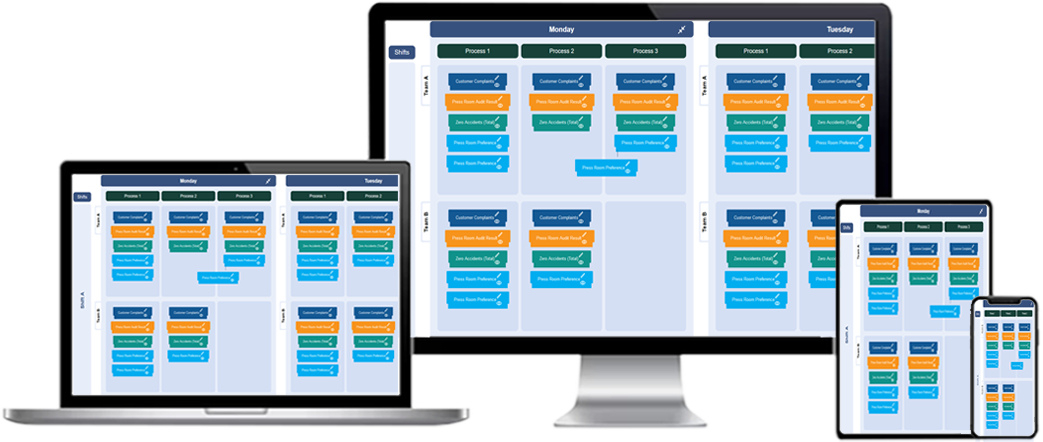
What Is T Card Software?
T Card software is a digital tool designed to replicate the traditional manual T Card system. It provides a visual task management platform where teams can organize workflows, track progress, and allocate resources effectively.

Key Features of the Best T Card Software in 2025
- Intuitive Interface: Drag-and-drop functionality and customizable workflows make task organization seamless.
- Cloud-Based Accessibility: Access T Card boards from anywhere with real-time updates for remote collaboration.
- Advanced Automation: Automate task scheduling, notifications, and status updates to save time.
- Customizable Boards: Adapt workflows to meet industry-specific requirements.
- Analytics and Reporting: Gain insights with dashboards, reports, and KPIs for better decision-making.
- Integration Capabilities: Integrate with other tools like CRM or project management software for cohesive operations.
- Mobile Compatibility: Manage tasks on the go with mobile-friendly designs.
- Role-Based Access Control: Secure sensitive information with role-specific permissions.

Benefits of Using T Card Software
Adopting advanced T Card software offers significant benefits:
- Enhanced Team Collaboration: Real-time updates improve communication and reduce miscommunication.
- Improved Task Visibility: Visual workflows help track progress and meet deadlines.
- Greater Efficiency: Automation eliminates repetitive tasks, boosting productivity.
- Flexibility Across Industries: Suitable for industries ranging from manufacturing to healthcare.
- Cost Savings: Reduces operational costs by minimizing manual processes.
- Data-Driven Decisions: Analytics provide actionable insights for strategic planning.
Use Cases for T Card Software
T Card software is versatile and used in various industries:
- Manufacturing: Manage production schedules and resources efficiently.
- Healthcare: Track patient appointments and treatment plans effectively.
- Service Industries: Monitor customer requests and team performance.
- Logistics: Organize shipment schedules and fleet operations.
- Education: Plan academic schedules and coordinate faculty responsibilities.
How to Choose the Best T Card Software in 2025
- Define Your Objectives: Identify workflow challenges and desired outcomes.
- Evaluate Features: Ensure the software offers essential functionalities.
- Test Usability: Use demos to assess the software's ease of use.
- Check Integration Options: Confirm compatibility with existing tools.
- Consider Scalability: Choose software that grows with your business.
- Assess Customer Support: Look for reliable and accessible customer service.
Future Trends in T Card Software
- AI-Powered Automation: Smarter task allocation and predictive analytics.
- Enhanced Collaboration Tools: Built-in communication features like chat and video conferencing.
- Sustainability Features: Digital solutions reduce paper usage, promoting eco-friendliness.
- Advanced Mobile Apps: Offline capabilities for uninterrupted task management.
- Industry-Specific Solutions: Tailored features for sectors like manufacturing and healthcare.
Conclusion
T Card software in 2025 is a vital tool for businesses aiming to enhance efficiency and collaboration. By adopting the right software, organizations can optimize workflows, reduce costs, and make data-driven decisions. As technology evolves, T Card software continues to empower teams with innovative features and flexible solutions.
Best T cards Software in 2025
What is T-Card software?
T-Card software is a digital tool that mimics the functionality of traditional T-Card boards, allowing organizations to track tasks, workflows, and schedules online.
How does T-Card software differ from physical T-Cards?
T-Card software offers additional features such as remote access, automated updates, reporting capabilities, and integration with other systems, unlike physical T-Cards.
What industries benefit from using T-Card software?
Industries like manufacturing, healthcare, logistics, construction, and education benefit from T-Card software for task and workflow management.
Can T-Card software be customized?
Yes, T-Card software can be customized to fit specific workflows, task categories, and organizational requirements.
What are the benefits of using T-Card software?
T-Card software enhances visibility, improves task tracking, allows remote collaboration, reduces manual errors, and provides data analytics.
Is T-Card software user-friendly?
Most T-Card software solutions are designed to be user-friendly, with intuitive interfaces and simple drag-and-drop functionality.
Can T-Card software integrate with other tools?
Yes, T-Card software can integrate with tools like ERP systems, project management software, and communication platforms for seamless workflows.
What features should I look for in T-Card software?
Look for features like customization, reporting, multi-user access, task prioritization, and mobile compatibility when choosing T-Card software.
Is T-Card software suitable for small businesses?
Yes, T-Card software is scalable and can be adapted for small businesses to efficiently manage tasks and workflows.
How does T-Card software improve productivity?
It provides a centralized platform for task management, reducing time spent on manual processes and improving task prioritization.
Can T-Card software be accessed remotely?
Yes, most T-Card software is cloud-based, allowing users to access and update tasks from any location with an internet connection.
What are some common use cases for T-Card software?
Common use cases include scheduling, resource allocation, production planning, and monitoring project progress.
Can T-Card software track team performance?
Yes, many T-Card software solutions include reporting and analytics features to track individual and team performance.
Is training required to use T-Card software?
Minimal training is usually needed due to the intuitive design of most T-Card software, though advanced features may require brief onboarding sessions.
Can T-Card software handle recurring tasks?
Yes, many T-Card software tools allow users to set up recurring tasks with predefined schedules and deadlines.
How does T-Card software help with deadlines?
It sends notifications or reminders for approaching deadlines and provides a clear overview of pending tasks.
Is T-Card software secure?
Yes, most T-Card software solutions include robust security features like data encryption and role-based access controls.
Does T-Card software support mobile access?
Yes, many T-Card software platforms are mobile-compatible, allowing users to manage tasks on the go.
How do I choose the right T-Card software for my business?
Assess your needs, such as required features, budget, scalability, and ease of integration, to choose the right T-Card software.
What is the cost of T-Card software?
The cost varies based on features, scalability, and licensing models. Many providers offer subscription-based pricing.